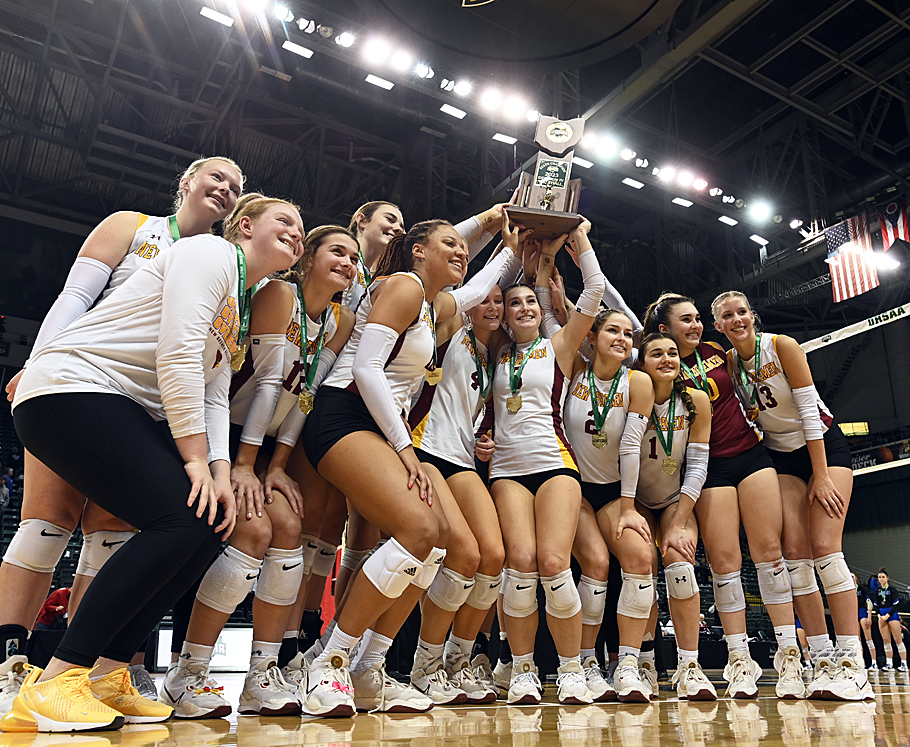
Seven divisions in baseball would mean more championship opportunities for schools the size of Russia (above, in 2023). (Press Pros Feature Photos)
Three weeks from the opening of the 2024-’25 high school sports seasons, there’ll be more of it than ever before – seven divisions of everything now – and a lot of questions over how, and why?
 In three weeks the ‘official’ start of the high school sports season begins for the school year 2024-’25. Traditionally, a glass-half-full symbol of normalcy, and a return to routine for households, community, and predictability.
In three weeks the ‘official’ start of the high school sports season begins for the school year 2024-’25. Traditionally, a glass-half-full symbol of normalcy, and a return to routine for households, community, and predictability.
Over the years there have been actually few new wrinkles – change – with the exception of the last decade when the OHSAA voted to add more divisions and more teams in football for the sake of competitive balance, and a broader effort for the sake of inclusiveness.
But this year, the 2024-’25 year, will see an expansion on the part of competitive balance that builds on the current seven divisions for football…to seven divisions for virtually every OHSAA sport – to include volleyball, boys and girls basketball, spring sports, et.al. That, too, seems to be have met with some glass-half-full/glass-half-empty appreciation.

The Hughes Law office, in Urbana, sponsors OHSAA and Buckeye sports on Press Pros. Call them today if they can help you Ph. 937-398-0520
For instance, a recent writer to this site posed this question about dividing football between the ‘big’ Division I schools from the ‘smaller’ Division I schools. Schools like Springfield (Clark County) would no longer have to play the mega-schools like Cleveland St. Ed to determine a state champion.
“If,” he wrote, “we’re dividing Division I so the smaller schools don’t have to play St. Ed, why is there nothing done in Division VII so the other schools don’t have to play Marion Local? Isn’t that competitive balance, too?”
Marion Local has won a record 14 state titles since 2000, and 14 of 17 state final appearances in Divisions V, VI, and VII under coach Tim Goodwin.
Of course, the fact is that Marion Local is playing schools their own size as a member of the Midwest Athletic Conference. Marion, at last check, had an enrollment of just over 100 boys in grades 9 through 12. They graduated less than 60 this past May.
But still, now the push is for more divisions to create, in the words of OHSAA Executive Director Doug Ute…more competitive opportunities for those member schools who might never experience the thrill of playing for a state championship. And at an OHSAA media gathering this past spring Ute went into detail explaining the virtues of such expansion – opportunities for athletes and member schools, alike.
Ute: “The smile on the face of a kid in this new format will be no different than that of the athlete from the traditional four divisions in basketball.”

Under the new division alignments, defending VII champion New Bremen will move up from Division VII to Division VI.
Or volleyball, baseball, boys and girls basketball. Glass half full.
And Ute ended his support for the change by adding, “This has been member-driven. We consulted member schools.”
But apparently not all member schools. On a recent trip to southeastern Ohio I contacted administrative personnel from four different districts. All of them said that they had no memory of being asked if they favored seven divisions in basketball. “I read about it online,” one said.
Now three weeks out, the support for seven divisions appears to be similarly fuzzy…those who say they were never contacted, or consulted, and some who simply shrug and say, “I guess there’s no harm.” Or, “Someone must have thought it was a good idea.” One district superintendent in Lawrence County noted, “I let my athletic director and principal handle those decisions.”

Huffer Chiropractic can help your athlete perform at their best – with offices in Osgood, Jackson Center, and Dublin, Ohio.
Others shake their heads and cite priority.
“This is a money grab,” says Don, a resident of Scioto County. “More divisions mean more games, more tickets sold, and more profit for the OHSAA.”
“It just waters down the competition. That’s all it does,” said David, from Pike County. “Why would you want a title when you know you didn’t beat the best to get it?”
Harold, from Gallia County: “We’re not teaching kids the right lessons by making it easier.”
In the view of three-quarters of those we asked, the overwhelming attitude seemed to be…glass half empty!
Ute also shared that due to the increase of regional competitions, additional, different venues would be necessary to host the games. And traditional one-stop locations like the Schottenstein Center in Columbus, and UD Arena in Dayton might not be adequate for seven championship finals for boys and girls basketball. This would create more of an already unhappy fan clientele who chafe over all OHSAA title events not being centrally located in Columbus.
“More travel, and more expense for the people in those districts,” reasoned Dan, from Coal Grove. “Besides, it’s always been a goal to play someplace like Ohio State (or presently, Dayton). Not someone else’s high school gym.”
Glass half full, again, there are those coaches out there who claim that, like Ute, you can’t have enough champions – that the impact is just as meaningful and profound.

Editor/publisher Sonny Fulks writes OHSAA and Big Ten sports for Press Pros Magazine.
“Under the old rules a school like ours had little chance of getting to the state finals,” said a baseball coach from southwest Ohio. “You had no chance against the bigger schools out of Cincinnati.”
But there was also this question from Roger, in Ironton.
“We’ve been getting beat in football by those good teams from northern Ohio. Usually, when something is discounted you pay less,” he noted. “I’m guessing there won’t be a reduction in ticket prices.”
He added: “I’d like to see the OHSAA give back $5,000 to each member school now, annually. They should share the wealth if they’re doubling the crop.”
That would amount to about four and one-quarter million dollars. And in the Toledo Blade article by David Briggs last year, he detailed how the OHSAA had accumulated $17.9 million as of July, 2023. It remains to be seen if more opportunity, more champions, and more smiles are worth that.
They did mention, however…more opportunitie$ for member schools!

